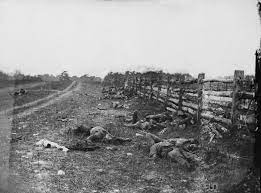Union troops took the Sunken Road in the Second Battle of Fredericksburg.
During the Second Battle of Fredericksburg, which took place on May 3, 1863, Union troops achieved a significant victory by capturing the Sunken Road, also known as the “Bloody Lane.” This battle was part of the Chancellorsville Campaign during the American Civil War and occurred near Fredericksburg, Virginia.
The Sunken Road was a key defensive position for the Confederate Army, commanded by General Robert E. Lee. The road itself was a depression in the terrain, forming a natural trench that provided excellent cover for the defenders. Confederate forces, led by General Lafayette McLaws, had fortified the road with rifle pits and artillery placements.
On the morning of May 3, Union forces under the command of General John Sedgwick launched an assault on the Confederate positions. The Union troops consisted mainly of the VI Corps and parts of the II Corps, totaling around 25,000 men. Their objective was to break through the Confederate defenses and advance towards Fredericksburg.
The initial Union assault encountered fierce resistance from the Confederates. The Sunken Road was defended by McLaws’ division, consisting of around 9,000 troops. Confederate soldiers poured devastating rifle and artillery fire into the advancing Union ranks, causing heavy casualties.
Despite the heavy losses, Union soldiers continued their assault, repeatedly charging towards the Sunken Road. The battle became a brutal close-quarters fight, with hand-to-hand combat taking place along the road. The Union troops displayed remarkable courage and determination as they pressed forward against stubborn Confederate resistance.
As the battle progressed, Union troops managed to breach the Confederate defenses at several points along the Sunken Road. The ferocity of the fighting earned the road its infamous nickname, the “Bloody Lane.” Confederate soldiers fought fiercely to hold their ground, but the overwhelming numbers and determination of the Union forces eventually prevailed.
By mid-afternoon, the Union troops had secured the Sunken Road, effectively breaking through the Confederate defenses. The Confederate soldiers retreated towards Fredericksburg, and the Union forces pursued them, marking a significant turning point in the battle.
The capture of the Sunken Road was a crucial achievement for the Union in the Second Battle of Fredericksburg. It opened the way for further advances and ultimately contributed to the Union victory in the larger Chancellorsville Campaign. The battle demonstrated the courage and tenacity of both Union and Confederate soldiers, as well as the devastating toll of the American Civil War. Today, the Sunken Road is preserved as part of the Fredericksburg and Spotsylvania National Military Park, serving as a reminder of the fierce fighting that took place on its historic grounds.
Hits: 0






